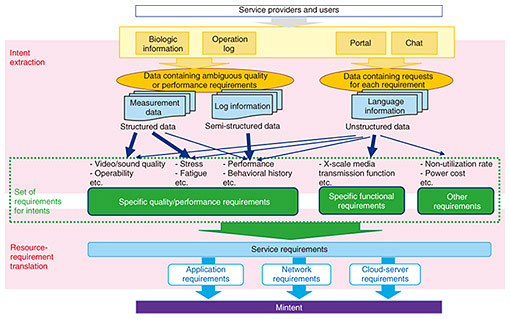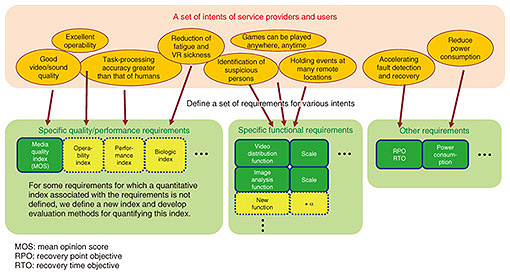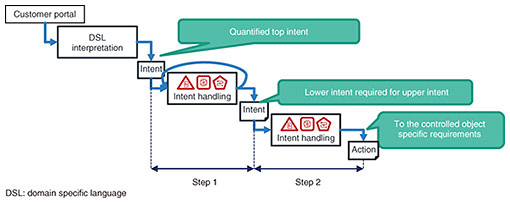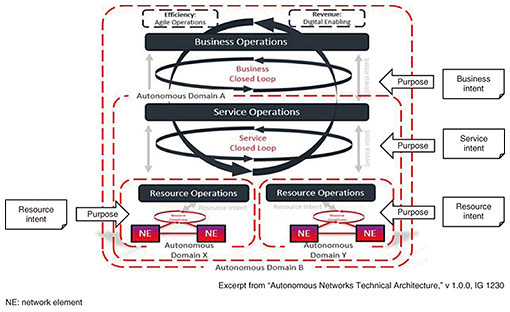 |
|||
|
|
|||
|
Feature Articles: Intent-based Application, Cloud-server, and Network Collaboration Technologies Vol. 20, No. 9, pp. 53–57, Sept. 2022. https://doi.org/10.53829/ntr202209fa7 Technology for Extracting and Converting Various and Ambiguous Intents to Implement MintentAbstractIn this article, we introduce an intent-extraction technology to extract intents of service providers and users in a next-generation communication service and a resource-requirement-conversion technology to convert these intents into resource requirements that can be used for resource control in the intent artificial-intelligence mediator (Mintent) that enables operations by taking into account various intents. Keywords: intent, intent extraction, resource requirements conversion 1. IntroductionAttention has been focused on intents, which are various demands for services, to create beneficial services for service providers and users. By accurately extracting these demands (intents) of service providers and users and enabling a cooperative resource control using network, cloud-server, and application information on the basis of these intents, i.e., the intent artificial-intelligence mediator (Mintent), it is possible not only to provide services in response to these demands but also to achieve efficiency of operation without decreasing the satisfaction of service providers and users by optimally designing and controlling resources on the basis of these intents. To implement Mintent, it is important to accurately understand the intents of service providers and users for services and convert these intents into requirements of adjustable indicators for operations. We introduce intents and related technologies in the following sections. 2. What is intent?Service providers and users have various demands for various services over a network. For example, virtual reality (VR) video-service users want to have an audiovisual experience as if they were in a real space, e-sports-service users want to have smooth operation without performance being affected, and users of an automatic operation or working robot want to achieve necessary tasks such as transportation and object detection more accurately and quickly than a human. While meeting user’s demands, service providers want to minimize the amount of data transmission to reduce operating costs or respond quickly to complaints for maintaining user satisfaction. We define these demands as intents and aim to enable service operation on the basis of these intents. Figure 1 shows the elemental technologies for achieving intent-based operation. Intents are not always given as specific requirements by service users or service providers. For example, ambiguous demands related to functional requirements, such as “enjoying watching sports” or “detecting suspicious persons,” or ambiguous demands that are not a specific index or required values related to the quality or performance of certain functions, such as “feeling of being there” or “achieving high accuracy,” can be assumed.
Because these ambiguous intents in service operation are difficult to use, we need to break them into specific requirements and define indices for these requirements (intent definition in Fig. 2). To express quantitative values of non-functional requirements related to quality or performance, we are studying the definition of general indices for various requirements and quantitative values for each index. Thus, we aim to implement Mintent by extracting a set of specific requirements of service users and service providers (intent extraction) and converting these requirements into adjustable indicators for operations in Mintent (resource-requirement conversion). The following sections introduce intent-extraction technology and resource-requirement-conversion technology.
3. Intent-extraction technologyIntent-extraction technology collects information related to the intents of service providers and users and extracts a set of specific requirements from this information. As intent-related information, we use (1) language information obtained through the input interface for service providers or users and (2) information related to these users that can be obtained in-service. An example of (1) is the language information received through a user portal or chat function. By using language-processing technology for this information, we extract the intents for specific demands or concerns. For example, when the service provider of a service that delivers real-time high-quality video of a professional sports competition gives language information such as “There is a suspicious person in the audience” or “A player is injured,” intents such as “detection of suspicious persons from images in corresponding area” or “remote diagnosis for the player” are extracted, and the required functions are extracted from these intents. We extract the quality and performance requirements necessary for each function (e.g., detection accuracy rate is 90% or more). We also aim to provide a flexible service that can automatically switch to the appropriate service plan from a pre-set one on the basis of the intents of service providers or users. An example of (2) is operation-log information. We extract intents of service users from changes in the behavior patterns obtained by analyzing the operation-log information. For example, in a service related to remote control, service interruption and time spent on each task are extracted from the operation log. If it is found that service users tend to stop using the service when the time required for the last specific task is long, intent related to performance is obtained. Specific quality or performance requirements (e.g., within 10% of the average time required for the task) is determined on the basis of the correspondence between the time and the user’s behavior. We aim to extract a set of specific requirements that service users and service providers have by using various types of information. 4. Resource-requirement-conversion technologyTo use Mintent for resource control, specific requirements extracted using intent-extraction technology need to be converted into indicators that can be controlled by the resource controller. In addition to intent extraction, we believe that a two-step function is necessary on the basis of discussions on standardization (Fig. 3).
Step 1 may include several steps of transformation from the business layer to a controlled target in a specific network domain. As specified in the standard, an architecture in which the management target and business are separated by several layers is the basis for developing systems such as a business support system and operation support system. Key performance indicators (KPIs), which represent the performance of the management target, exist for each operation-management layer and have relationships (structures) across layers. We believe that the technology to extract qualitative intents and achieve Step 1 can be developed not only by conventional machine learning but also by taking into account the hierarchical KPI structure and implications of KPIs for intents. The intent discussion in the standardization is treated as the purpose of the closed loop mechanism in each layer that enables an autonomous network for automating the operation (Fig. 4). Intent based on understanding the abstract requirements of the users that we aim to achieve not only automates the operation but also contributes to enhancing customer management by increasing user satisfaction [1].
We are not only targeting services such as CaaS (Connectivity as a Service) services, e.g., network slices of 5G (5th-generation mobile communication systems), but also aiming to establish technologies to extract user requirements for end-to-end services including application functions provided on those services. 5. ConclusionWe introduced technologies to be studied to enable operations corresponding to various intents of service providers and users. In addition to the development of these technologies, we will participate in the proof of concept (Catalyst Project) at the TM Forum, an industry association for communication service providers and their suppliers, to increase awareness of these technologies, discover applicable business scenarios, and promote research and development so that the technologies can be used for a wide range of business requirements. We will also standardize the intent model and API (application programming interface) requirements and quantification of intent metrics as needed. Reference
|
|||






